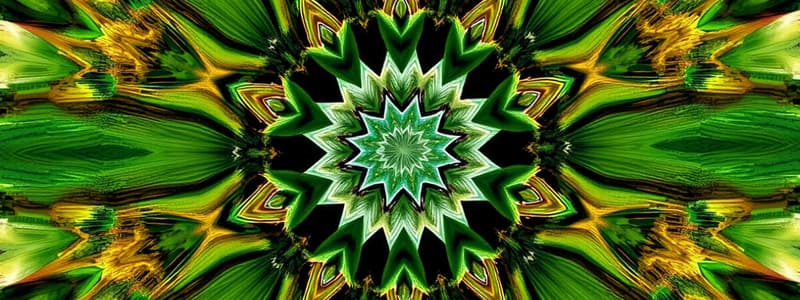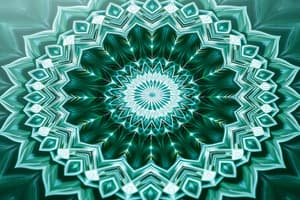Podcast
Questions and Answers
What defines a pattern in mathematics?
What defines a pattern in mathematics?
- A random arrangement of elements.
- An absence of repetition among features.
- A series of regular or consistent arrangements according to specific rules. (correct)
- Any design that is visually appealing.
Which of the following describes symmetry?
Which of the following describes symmetry?
- Parts of an object being mirror images across an imaginary line. (correct)
- A curved pattern revolving around a central point.
- Circular patterns that appear in geometric shapes.
- Lines or bands differing in color next to each other.
What is a characteristic of a meander?
What is a characteristic of a meander?
- A series of straight lines.
- A rapid change in color patterns.
- An arrangement of dots forming a circular shape.
- Sinuous curves or windings in a watercourse. (correct)
Which type of pattern includes the concept of self-similarity?
Which type of pattern includes the concept of self-similarity?
What is true about tessellations?
What is true about tessellations?
Which of the following patterns is NOT a type of natural pattern?
Which of the following patterns is NOT a type of natural pattern?
What defines a logical pattern according to the characteristics provided?
What defines a logical pattern according to the characteristics provided?
Which pattern is characterized by linear openings forming due to stress?
Which pattern is characterized by linear openings forming due to stress?
Which of the following describes a number pattern where the difference between consecutive terms is constant?
Which of the following describes a number pattern where the difference between consecutive terms is constant?
How are prime numbers characterized?
How are prime numbers characterized?
What does the Fibonacci sequence start with?
What does the Fibonacci sequence start with?
Which pattern describes the series: 1, 4, 9, 16, 25?
Which pattern describes the series: 1, 4, 9, 16, 25?
Which of the following statements is true regarding Fibonacci numbers?
Which of the following statements is true regarding Fibonacci numbers?
What is the defining characteristic of composite numbers?
What is the defining characteristic of composite numbers?
Which term describes a sequence where each term is multiplied by a constant to generate the next term?
Which term describes a sequence where each term is multiplied by a constant to generate the next term?
In poetry, what does a rhyme scheme refer to?
In poetry, what does a rhyme scheme refer to?
Flashcards are hidden until you start studying
Study Notes
Patterns in Nature and the World
- A pattern consists of repetition and arrangement according to a specific rule or sequence.
- Types of natural patterns include symmetry, spirals, stripes, spots and dots, meanders, and cracks.
Types of Natural Patterns
- Symmetry: Objects exhibit symmetry when halves mirror each other along an imaginary line.
- Spiral: Curved patterns often found in nature, centered around a focal point.
- Stripes: Lines or bands of differing colors or tones seen in various animals.
- Spots and Dots: Distinctive circular patterns on animals and plants that vary in size and color.
- Meander: Regular curves and bends in the paths of rivers or streams.
- Cracks: Linear openings in materials indicating stress relief, demonstrating elasticity.
Main Types of Patterns
- Logical Patterns: Identified through rotating shapes, size changes, alternating colors/shapes, and mirror images.
- Geometric Patterns: Repeating shapes create cohesive designs, including:
- Tessellations: Repeating polygons covering a plane without gaps.
- Fractals: Self-similar mathematical constructs, examples include Sierpinski Triangle and Koch Snowflake.
- Word Patterns:
- Analogy: Comparisons of two different items by breaking them down into parts.
- Rhyme Scheme: Pattern of rhymes in poetry or songs.
- Haiku: A three-line poem with a 5-7-5 syllable structure.
- Number Patterns: Sequences that adhere to a specific numerical rule:
- Even Numbers: Numbers divisible by 2 (e.g., …, -10, -8, 0, 2, 4, …).
- Odd Numbers: Numbers not divisible by 2 (e.g., …, -9, -7, 1, 3, …).
- Prime Numbers: Whole numbers greater than 1 with no divisors other than 1 and themselves (e.g., 2, 3, 5, …).
- Composite Numbers: Numbers with more than two factors (e.g., 4, 6, 8, …).
- Arithmetic Sequence: A sequence where each term is derived by adding a constant (common difference).
- Geometric Sequence: A sequence where each term is derived by multiplying by a constant (common ratio).
- Triangular Numbers: Represents a triangle's dot arrangement (e.g., 1, 3, 6, 10, …).
- Square Numbers: Squares of integers (e.g., 1, 4, 9, …).
- Cube Numbers: Cubes of integers (e.g., 1, 8, 27, …).
The Fibonacci Sequence and the Golden Ratio
- The Fibonacci Sequence is defined by each number being the sum of the two preceding numbers, starting typically with 0 and 1.
- Named after Fibonacci, derived from the rabbit breeding problem, illustrating its emergence through natural growth patterns.
- Notable properties include:
- Every nth Fibonacci number is divisible by F(n).
- The sum of squares of two consecutive Fibonacci numbers results in another Fibonacci number.
Studying That Suits You
Use AI to generate personalized quizzes and flashcards to suit your learning preferences.




